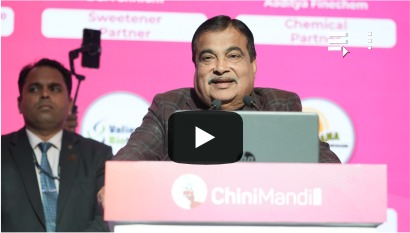In an exclusive interview with ChiniMandi’s editor Prakash Jha, Hans Ole Klingenberg, Vice-President for Marketing and Strategy, Household Care and Industrial Biosolutions, Novonesis, shared valuable insights into the rapidly evolving biofuels sector. Klingenberg, with extensive experience across the U.S., South American, and European markets, discussed the growing significance of second-generation (2G) ethanol, a key renewable fuel derived from non-food biomass. As India positioning itself as a major player in ethanol space, Klingenberg highlighted the country’s unique advantage in feedstock availability for 2G ethanol production. With the recent policy shifts allowing 2G ethanol exports, India is poised to enhance its biofuel capacity, contributing significantly to both its energy security and environmental sustainability goals.
Q. With your vast experience in US, South American, and European markets, what are the key differences you’ve observed in the adoption of biofuels across these regions? How does India fit into this global landscape?
Ans: India has had some very impressive growth rates for biofuel expansion. In fact, we have never seen a rollout in any part of the world move this quickly or this smoothly, thanks to a very determined and structured approach by the Indian government. We applaud the government for finding a balanced way to manage both feedstock availability, as well as the rollout of new plants. The government’s structured approach in setting targets, mandates and timelines helped to create a very clear signal to the market. This is something that has also been instrumental in Brazil and the US. In these contexts, we have seen that the role of carbon markets, and related policy support has been critical for producers to invest and grow the low carbon fuels market as well. We hope for continued support from the India government as it continues its journey to decarbonize the transport industry in India, and we see room for additional expansion here.
Q. What role do you see biofuels playing in the global transition to renewable energy, and how does this align with Novonesis’ strategy for Household Care and Industrial Biosolutions?
Ans: Liquid renewable biofuels are a critical component in decarbonizing transport. In fact, it is the cheapest and greenest way to decarbonize road transport quickly. It also presents a fantastic way to create other social benefits as it supports local farm communities and jobs. It ensures less dependence on fossil fuel imports, and it provides a means for cleaner burning engines and less air pollution in the cities. As such, we see biofuels as being an instrumental tool that can be used here and now. As the world makes transitions towards low carbon strategies, there cannot be a one-size-fits-all solution towards mobility. Biofuel will be key, but also one among several solutions towards cleaner and greener transitions.
Biofuels also serve as a bridge to decarbonize hard-to-abate sectors. Long term, it’s also possible that biofuels may be used as an alternative for aviation fuels. Investing in biofuels now also creates the potential to invest and become a leader in future solutions for not just road transport, but also for heavy transport solutions that are greener.
Q. With India recently permitting the export of 2G ethanol, how do you foresee this decision shaping the future of the country’s biofuel industry? What opportunities does this open up for scaling up production, and what steps will be crucial for overcoming potential challenges in meeting global demand?
Ans: India does have a potentially very advantageous position when it comes to feedstock for 2G ethanol. So, it will be very interesting to see how this industry scales. It opens up potential new sources of income for the biofuel industry and for India as a whole.
Some of the critical things that will be very important to pay attention to when it comes to the 2G ethanol market is the premium and the mandates that are made available to this specific fuel category, as it is more expensive than 1G ethanol. As an example, in the EU there is a premium price afforded to 2G ethanol, but right now those prices are still relatively low, and will likely need further government support to allow the industry to fully scale. It’s also going to be critical to ensure that the current 2G ethanol plants that are being commissioned can scale successfully. In the past, there have been challenges to get this process technology up and running. However, we are optimistic that the industry is becoming more mature and is getting to a stage where it is able to get to true scale and thus be able to grow this market.
Allowing exports of 2G ethanol will facilitate price discovery, thus helping to establish a clear reference point for potential investors in the advanced ethanol sector. This is currently lacking in the local market. A continued trade/ demand certainty through exports would build trust and draw investments in this space, which is essential to scale up the industry.
Q. How do you perceive India’s agricultural landscape as a resource for the biofuels industry, especially in terms of raw material availability for 1G and 2G ethanol?
Ans: I think the critical piece here is to make sure that there is a continual focus on balancing feedstock supply and feedstock demand. Here, I think India actually offers a best practice for balancing the use of raw material. There is an annual accounting for feedstock availability of broken grains / rice, corn and sugar. This enables the Indian government to determine how much feedstock availability is reasonably available for biofuel generation, and work forwards to create standards and mandates for how much feedstock may be offered towards ethanol production in a given year. This ensures that there’s always a balance in resource utilization, and it promotes growth and expansion of value for farmers by giving them several outlets for crops, be it for food, or fuel.
This also allows the government to flexibly pivot if demand is stronger from say food rather than fuel, or vice versa – thus making sure that crops are not wasted or left in excess stock thereby resulting in low output prices for farmers. India has significant biomass availability so it can play a pivotal part in developing and scaling up the 2G industry – complementing ethanol production from existing feedstock and furthering India’s energy security and sustainability ambitions.
Q. With India’s strong push towards biofuels, especially in light of the ethanol blending and export policies, do you foresee a significant increase in investment in India’s biofuel sector?
Ans: We have seen very significant investments in India’s biofuel infrastructure in the past few years, and in fact, that investment path has been so strong that it’s helped India achieve its 20% blend rate 5 years ahead of the initial timeline. With 20% blending being reached this year, it seems evident that there will be a pause in investments here in the coming year while the government works to reassess the balance of feedstock and what the future blend rate should be. From our outside perspective, it does look like India has potential to grow higher than 20% blend given the amount of feedstock available, and also with the new growth potential that could be unlocked through future agricultural productivity gains. This could potentially enable India to move closer towards the type of setup that, for example, Brazil has, where they’re planning an increase in their blending mandate from 27% to 30% ethanol, and still meeting all their goals in terms of food availability, energy independence and decarbonization.
Q. What role do you believe biofuels will play in India’s energy security strategy, and how can they help the country move towards achieving its net-zero emissions goals by 2070?
Ans: Biofuels are a critical tool here. India’s approach to biofuels have been very holistic and unique in many ways. Having already displaced 1/5 of the gasoline pool in road transport is an amazing accomplishment. The potential to add another 7% blend rate is certainly there for 1G ethanol. In addition to that comes the potential that 2G ethanol represents – which could significantly reduce emissions from the current baseline in not only transportation but potentially also in biochemical production (with ethanol being the precursor molecule). Down the road there could potentially also be a biodiesel blend that could be say 5 to 10%. Through SATAT scheme, the Government is also enabling development of biogas/ CBG ecosystem – one of the very few countries to have blending target in CNG vehicles and PNG supplies.
In this world, India has become one of the leading global forces in biofuels, and biofuel technology. As we think longer term, down the road there is also the potential for use of these biofuels in new areas such as sustainable aviation fuel and marine fuel (HVO). So, as we electrify more vehicles on the road, there’s potential to pivot some of that road biofuel towards airplanes, which will not be easily decarbonized with electric systems. Here India’s focus and investments in biofuels now, can position India as a leading player in these future markets.
Q. Looking ahead, what do you think the future holds for biofuels in India’s transport and energy sectors?
Ans: As with other regions and countries, I think India should play to its strengths. And that means thinking about what mix of different technologies are going to best suit the diverse needs of India across both the transport and energy segments. This means looking at different renewable technologies, be they solar, wind, biofuel, gasification or other technologies.
India does seem to have some of the same characteristics as countries like the US or Brazil, where you have very strong natural agricultural resources. India is also a very strong technology player and has a very strong and highly skilled workforce to build strong new renewable industry sectors. For those who lead the path, there is a real opportunity to become one of the leading global players in these future energy spaces. So, we believe there is a tremendous amount of opportunity for India when it comes to future renewable energy sources. For example, with the anticipated increase in CBG capacity and the implementation of blending targets for CNG supplies, India is poised to achieve largest volume substitution of natural gas with biogas/CBG in both transport and heating sectors.
Q. As India becomes a major player in the biofuels market, what do you think are the opportunities for international collaboration in terms of R&D, technology transfer?
Ans: India has the benefit of stepping into biofuels after several decades of technology development in the Americas. That also means that India has the potential to leapfrog and start with the newest technology and then adapt it to the specific needs of the Indian market. As such, we see a lot of potential for collaboration, both when it comes to engineering technology for bioethanol plants, as well as the biology that gets put into those biorefineries. As an example of that, we are currently working to make advanced yeast technology available early on for India to take advantage of. This is technology that has been developed in the US over several years, and India in this case has an opportunity to leapfrog to the latest generation of this technology early in the buildup of this industry. From here, we imagine India can also play a very strong role in developing new technology, for example when it comes to 2G ethanol, where we see India taking a leading role in beginning to build out this type of factory based on feedstocks that are uniquely suited to the India market, but also other global markets.
Q. As a leader in biosolutions, Novonesis is known for its innovative approach. Could you share some of the cutting-edge technologies or projects Novonesis is working on that could potentially revolutionize the biofuels industry, especially in emerging markets like India?
Ans: As I mentioned before, our advanced yeast technologies are some of the most important new technologies that we’re working to bring to our valued customers in India. These new advanced yeasts are both able to produce more ethanol, and they are also more robust toward a variety of changing production conditions. These new yeasts are also able to produce some of the enzymes that are necessary to run the bioethanol process, all in one simple biosolution. Looking beyond this type of yeast, we’re also looking to innovate new solutions that can help Indian bioethanol customers diversify their revenue streams. This includes new technologies for extracting more corn oil, that can be used as a feedstock, for example for biodiesel. Additionally, our biosolutions could upgrade the value of the DDGS, the animal feed product that also comes out of an ethanol plant, such that this feed component becomes more valuable to end customers. This provides a basis for a broader and more robust income base for bioethanol refineries in the future.
Novonesis also has a portfolio to augment biogas recovery/ yield by significant margins, helping improve the economics of the plants.
Q. Given Novonesis’ international footprint, how is the company engaging with countries like India to promote biofuel adoption, and what kinds of partnerships or collaborations are you exploring in the Indian market?
Ans: We work very closely with all the players across the value chain in the India biofuels market. That includes first and foremost our very dear customers as well as our close distribution partners. We also engage directly with a number of coalitions and stakeholders that support this industry, such as the Indian Federation for Green Energy, as well as other industry groups that support and contribute towards sustainable mobility and bioenergy. As such, we are seeking to make sure that we support the industry as a whole and help advocate for a balanced and sustainable approach to biofuels.
Q. In terms of scaling up 1G and 2G ethanol, what steps is Novonesis taking to reduce production costs and improve efficiency? How do you plan to address challenges for ethanol production?
Ans: We have been investing and innovating in biofuels for many decades, and we will continue to invest and innovate in biofuels for many more years to come. It means that we’re constantly looking for ways to improve productivity and profitability for our customers, as well as to drive value through diversification of revenue streams or other benefits that may help our customers sustain better operations. Over the past 10 years, we have thus helped our global customers improve their profitability every single year, year over year, with new technologies. We anticipate that this trend is going to continue both for 1G as well as for 2G, as we still see significant potential to improve and advance technologies for biofuels. So, we are very excited about continuing to innovate and support our customers and see this industry as holding significant promise for the future.
Q. Finally, as the biofuels industry faces both opportunities and challenges, what are Novonesis’ long-term goals in this sector? How do you envision your company contributing to the global push towards a greener, more sustainable energy future?
Ans: The very foundation for our company is to make the world a better place one day at a time. Biofuels is a major part of our business and is approximately 20% of our global turnover. Strategically it is an important business area for us. We believe there’s significant potential and the expansion of biofuels can work to solve the fundamental problems of decarbonizing road transportation, as well as potentially marine and aviation transportation in the longer term. Biofuels can’t solve all our challenges in decarbonizing transport, but it is the most economical and readily available tool here and now to mitigate carbon emissions from an ever-growing global fleet of gasoline cars. There’s a lot of work to do, and we’ll continue to work tirelessly to support this industry with new technologies, while we can continue to move the needle and transition the world to a greener, more sustainable future.


















